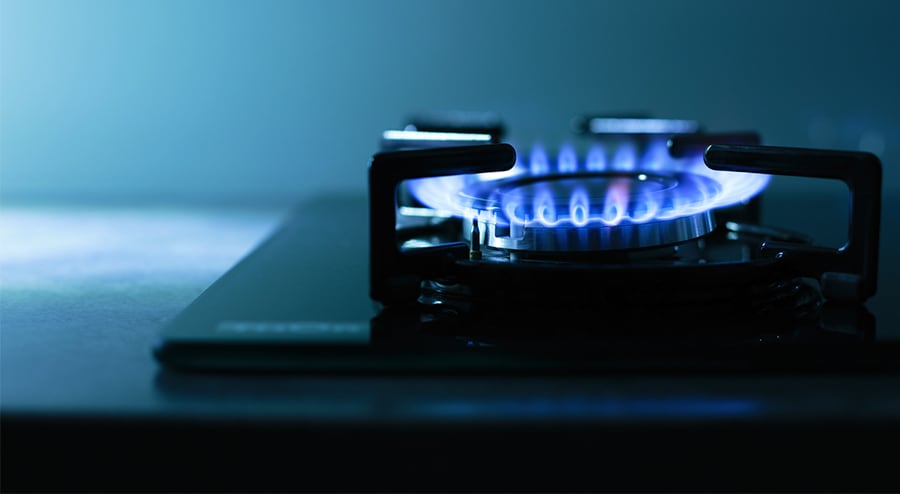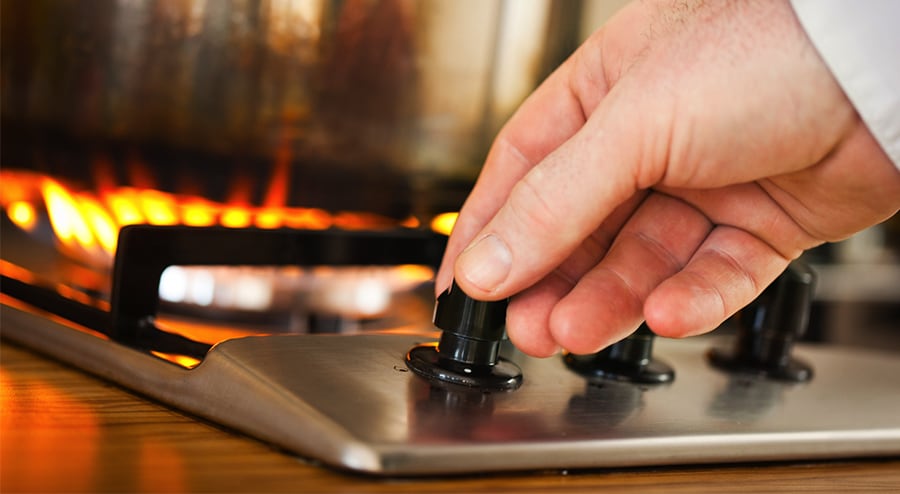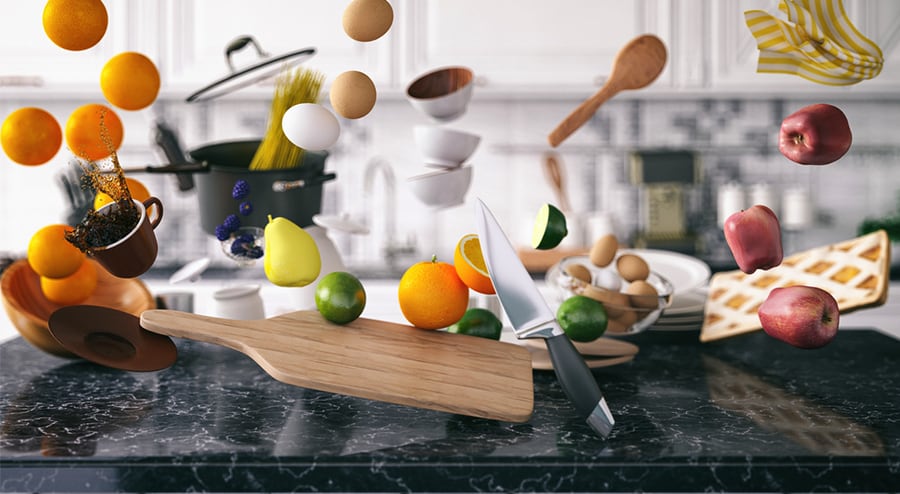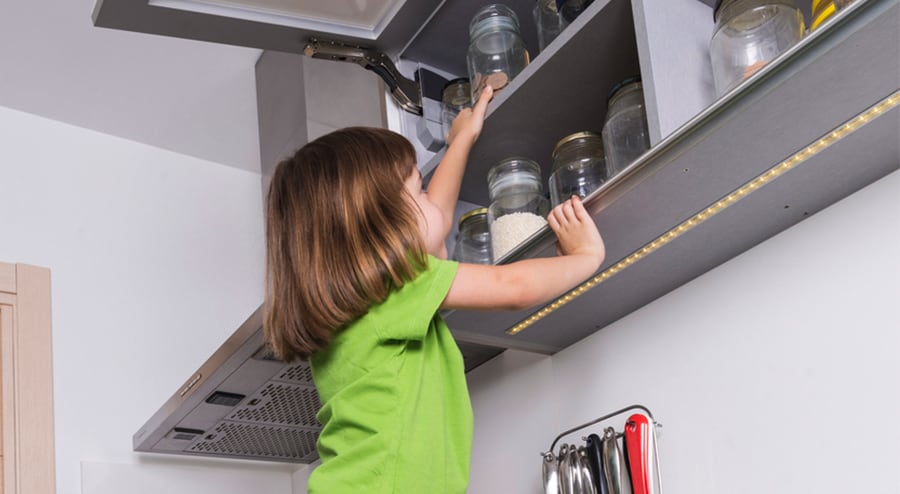You want to believe that there is no place safer than your own home, and for the most part, that’s the case. However, home isn’t without its hazards, and if you’re cooking, the kitchen can be one of the most dangerous places in the house. According to the National Fire Protection Association, for example, cooking equipment was involved in one out six home fire deaths from 2010-2014, and involved in two out of five home fire injuries. And kitchen-related knife injuries made up about a third of the 400,000 knife-related injuries estimated to take place each year.
Fortunately, there are things you can do to keep yourself and your family safer in your kitchen. By making a few simple adjustments, you can significantly decrease the probability of having an accident or being injured. Your family’s welfare is worth the effort.
What to Do in Case of a Fire
Cooking equipment starts more than 150,000 house fires a year. Of cooking fires in the home, ranges caused 59 percent of them, and 38 percent were caused by cooking equipment that was unattended. Make fire safety a priority in your kitchen.
- If a fire starts in a pan or pot, immediately turn off the burner or heat source, then use a wet towel to cover it. Allow it to cool before moving.
- Keep a fire extinguisher in your cooking area and know how to use it.
- Don’t throw water on a fire. Water can make the fire more intense and can cause it to flare and spread.
- If you have an oven fire, turn off the oven immediately, and do not open the door.
Safety Precautions for Cooking with Oil
63 percent of stove fires are caused by frying. Cooking with oil requires some special care.
- Stay in the kitchen when you fry anything on the stove so you can keep an eye on it.
- Pay attention to what you are frying. If you notice the oil begins to smell or you see smoke (even wisps), turn off the burner immediately and use a pot holder to move the pan from the burner.
- When sautéing or frying, slowly bring the oil up to the temperature you need.
- Don’t drop food in a pan of oil – it will splatter. Carefully place it. Use a spoon if necessary.
- Always keep your pan lid handy. If a fire starts, you can slide the lid over it to cover the pan. Then turn off the heat. Don’t uncover it until the pan is completely cool. Never use a fire extinguisher or water on a grease fire.
- If you can’t get the lid on the pan or the fire is elsewhere on the stove or counter, get everyone out of the house and call the fire department.
Safety Precautions for Outdoor Grilling
Experts estimate that each year grill fires cost $37 million in property loss. Gas grills account for 79 percent of home grill fires.
- Clean your grill regularly to remove the fat and grease build up.
- Do not use grills indoors or near deck railings or siding.
- Never light your grill with the lid closed.
- Never leave your grill unattended.
- Do not allow children and pets within three feet of a hot grill.
- Do not dispose of coals until they have cooled completely.
Food Safety and Hygiene
According to the CDC, foodborne illness causes 76 million illnesses, 325,000 hospitalizations, and 5,000 deaths each year in the U.S. alone.
What’s more, your kitchen may not be as clean as you think. Many gastrointestinal upsets someone might brush off as a “stomach bug” are actually foodborne illnesses that come from improper food handling. Symptoms can range from cramping and diarrhea to nausea and vomiting to headaches. Take these precautions to keep your family’s food safe.
- Wash your hands – with soap. Before you handle food and after, wash your hands for at least 20 seconds with warm, soapy water.
- Avoid cross-contamination by keeping raw meat, fish, and poultry (as well as their marinades and juices) from touching other food.
- Wash your cutting board, knife and other utensils, and your preparation area with hot, soapy water.
- When marinating poultry and meat, refrigerate it and keep it in a covered container.
- Sanitize countertops, utensils, and cutting boards using 1 tablespoon of chlorine bleach (unscented) to 1 gallon of water.
- After thawing meat (unless it is refrigerated) cook it immediately.
- Thaw frozen meat in the refrigerator and keep the juices from touching or dripping on to other foods.
- Cold water is another way to thaw frozen meat and it’s a little faster. Put the meat in a sealable bag (make sure it’s waterproof) and submerge in cold (not tepid) tap water. Every 30 minutes, change the water.
- Follow this guide for safe internal food temperatures:
- 145 degrees F – Beef, lamb, pork, veal roasts, chops, and steaks.
- 160 degrees F – Ground meats including beef, lamb, pork, and veal.
- 165 degrees F – Poultry.
How to Use Knives Safely
In a survey by the National Hospital Ambulatory Care Association, cuts were the number five reason for visits to the emergency room. In addition, cuts or lacerations account for almost half (42 percent) of all emergency room hand injuries. To keep yourself out of the ER, follow some simple rules about knife safety.
- Use a cutting board and make sure it’s stable.
- Never cut food or anything else while you hold it in your hand – use a cutting board.
- A knife is for cutting, not for prying off lids or opening cans.
- If your knife falls, DO NOT try to catch it. Step back (so it doesn’t cut your foot) and let it hit the floor.
- Store knives in a knife holder, not a drawer.
- Keep your knives sharp. Dull knives are dangerous because they may require you to put more force into cutting than you can control.
- Hand wash your knives – the dishwasher can ruin the edge. Again, a dull knife is a dangerous one.
Holiday Cooking
Holiday cooking usually means lots of family and friends – and lots of distractions. If you are cooking for the holidays, it is important to keep your mind on what you are doing. When you stop paying attention, accidents happen.
- Don’t leave your cooking equipment unattended.
- Try to keep young children out of the kitchen.
- Keep pot handles turned inward so that children cannot grab them and they can’t snag someone passing by.
- Limit the number of people cooking in the kitchen at one time.
- If you have young people helping with chopping or other preparation, make sure that they know how to do it safely.
Preventing Falls in the Kitchen
The CDC estimates around 8 million people are injured due to falls every year. The kitchen is a prime location for slips. To avoid this serious hazard, you should:
- Clean up any spills immediately so you don’t forget about them, step in them, and fall.
- Keep cabinet doors and drawers closed. Open doors can cause you to trip or knock you off balance.
- Keep items that you use often within easy reach and at eye level if possible. That way you don’t have to reach up high or stoop to get anything.
- Remove any items that may get underfoot, such as pet food bowls. You can forget they are there and trip over them.
- Keep a step stool in your kitchen so you can reach items on high shelves. Choose one that is sturdy and has rails. Don’t use a chair!
- If possible, banish pets and small children from the kitchen while you’re cooking. You can trip over them, harming them and you. If you have small children who can’t be left alone, use a playpen or highchair to keep them confined while you cook.
Everyone knows a horror story about an accident that happened in the kitchen, whether it’s a fire, an accidental cut, or some species of food-borne illness. The good news is that if you take precautions and learn how to avoid some common dangers, your horror story never has to have you as its main character.





